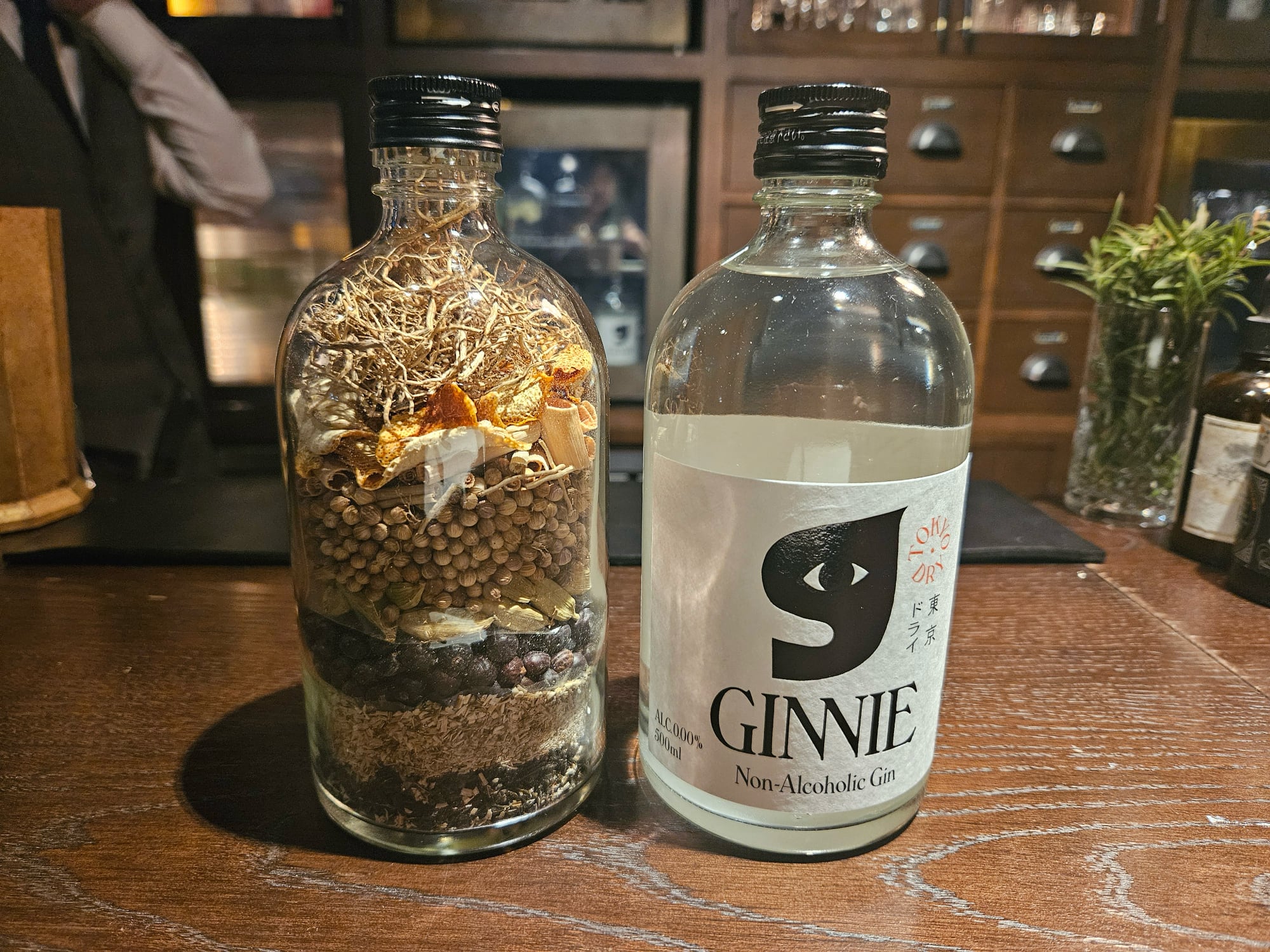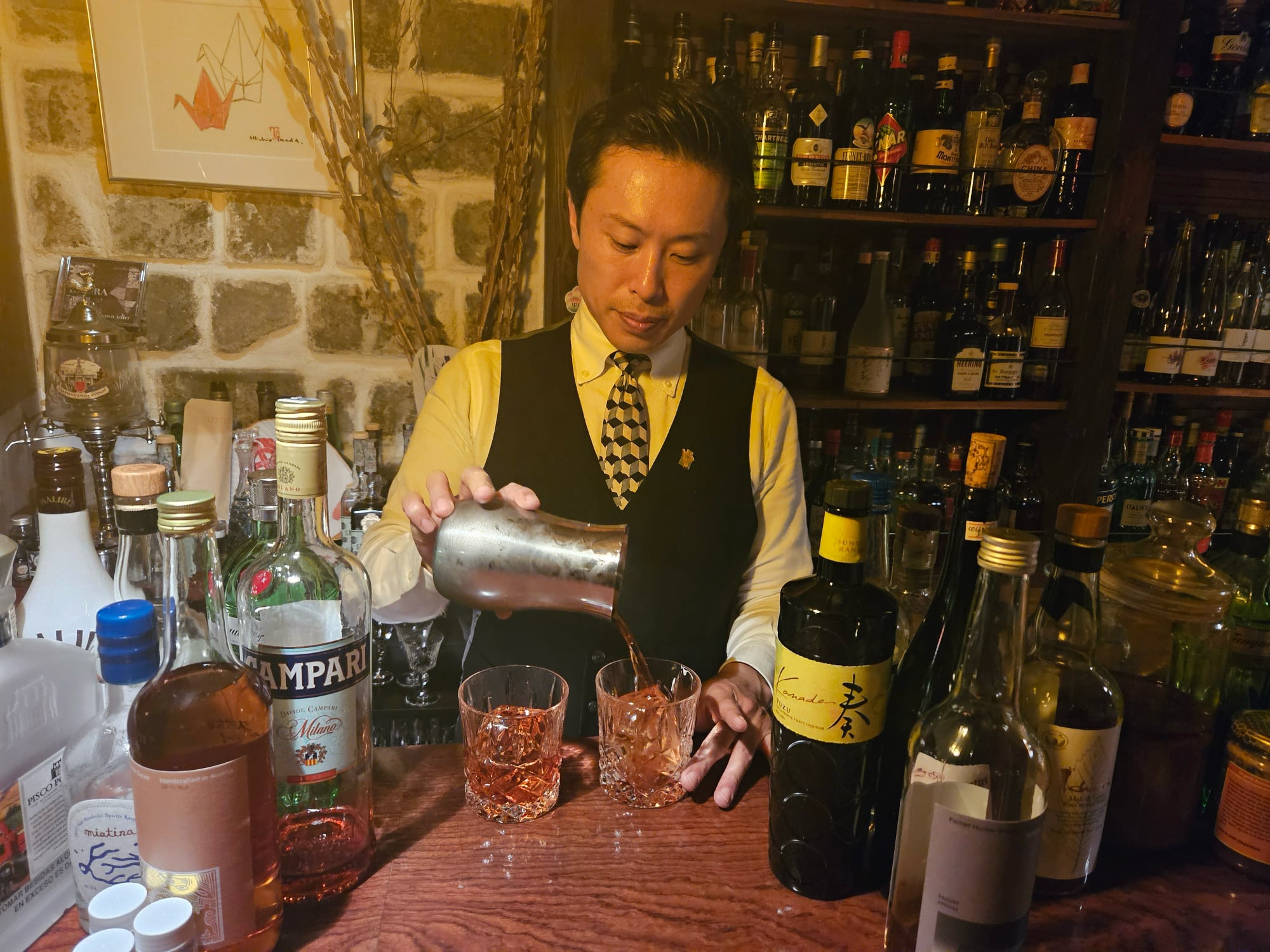Decades of recession, less work-related drinking and greater health consciousness have shrunk Japan’s alcohol consumption. Leading global drinks data and analytics provider IWSR (formerly International Wine and Spirits Record) lists Japan in the world’s top 10 no/low alcohol markets — forecast to grow another 5% by 2027. Japan’s best bartenders are adapting fast.
Shuzo Nagumo is the CEO of Spirits & Sharing, an alcohol-related services company which owns seven Tokyo bars.
“The nonalcoholic beverage market is larger than the alcoholic market, and further innovation in nonalcoholic drinks is expected to continue in the future,” Nagumo said.
Nagumo’s chief technical officer, Manabu Ito, has around 37 years of bar experience.
“When I first started working during the economic bubble era, Japan was full of hardworking people who stayed late and drank heavily to keep going. Younger people, in particular, drank a lot back then.”
Ito said younger people today seem to drink with a clearer purpose. They research bars and drinks online, then choose them based on their personal likes. Also, older people are drinking noticeably less, especially after the COVID-19 pandemic.
A pioneering bar’s journey

Hiroaki Takahashi, Low-Non-Bar manager and Ginnie production manager, decided to try to enjoy alcohol at 30 years old. Image: Low-Non Bar
A surprising number of Japanese bartenders only drink small amounts of alcohol or none at all.
“Japanese DNA variations make it impossible for certain individuals to process alcohol,” said Nagumo.
A bar manager at a luxury hotel venue shared another reason: “I only drink alcohol once a week to preserve my palate.”
Hiroaki Takahashi is the bar manager of Japan’s first nonalcoholic bar, Tokyo’s Low-Non-Bar, which opened in 2020.
Referring to its founder, Eiji Miyazawa, Takahashi said: “He stopped drinking around 2018 due to health reasons. Nowadays, he sometimes drinks in small amounts because he loves bars.
“As for myself, I have been a bartender since the age of 20, but I rarely drank outside of studying in bars until I turned 30, as alcohol would negatively affect my health.”

Ginnie nonalcoholic gin (¥3,200) and a bottle showing its plant ingredients like juniper berries, Japanese spicebush, jasmine tea, coriander seeds, lemongrass. Image: Audrey Foo
Low-Non-Bar serves zero-, low-alcohol (up to 3%) and alcoholic drinks. Patrons can order alternating levels of alcohol — Takahashi calls this “liver sustainability.”
Takahashi adds premium ingredients like seasonal organic produce, truffle-infused honey, homemade syrups and aromatic waters to subtle-tasting, alcohol-free spirits — with complex, flavorsome results.
Originally, the whole menu was zero-alcohol. After COVID travel bans ended, liquor was added to meet foreigners’ requests. The current clientele is mostly in their 30s: about 40% male, 60% female, 60% teetotallers and 40% drinkers.
However, Takahashi thinks Japan remains behind bars overseas — like a "nonalcoholic isolation state” — because it bans nonalcoholic spirit imports due to regulations on additives.
In 2024, Low-Non-Bar released its own nonalcoholic gin, Ginnie. Without alcohol’s preservative and flavor extracting properties, it has a shorter shelf-life and requires twice the amount of botanicals compared to alcoholic gin.
Three alcohol-free Ginnie cordials with extracts like cypress, vanilla and dealcoholized sake are also available.
Futuristic bartending in traditional Kyoto

Hiroaki Oda has been bartending for 17 years and makes his own nonalcoholic spirit, Miatina, bitters and vermouth. Image: Audrey Foo
Bartender Hiroaki Oda also busts the myth that mocktails are just sugary, uninspired concoctions. At Oda’s Bar Ixey in Gion, there’s no menu as he customizes guests’ alcoholic or nonalcoholic beverages.
“The reason why I make nonalcoholic cocktails is because I want to be ready to pass on the culture of the bar, which I love, to the next generation.” In the past two years, he’s received many nonalcohol requests from young people, but also people in their 40s.
Bar Ixey features “drinkable perfumes” crafted with botanicals (many from Oda’s private herb garden) and an aroma extractor. The fragrances are 10 to 100 times more concentrated than a typical herbal tea.
Without ethanol’s viscosity, creating texture in alcohol-free drinks is challenging.
“It is important to compensate for a lack of body by adding concentrated aroma. Whether or not it has a concentrated aroma makes a huge difference,” Oda explained.

Oda's second bar is in a 140-year-old townhouse where zero-alcohol and alcoholic drinks are served by bartender Tamura Seiji. Image: Audrey Foo
During the COVID lockdown, Oda closed his bar and experimented with distillations.
“Then the Japanese government banned the serving of alcohol after 8 p.m., so we did a nonalcohol bar. This was one of those grand social experiments that rarely happen, because without it, customers would never have had three nonalcoholic cocktails all in a row.”
Oda distilled about 140 different plants, and chose the best results to create Miatina, a 0%- alcohol spirit. Today, there are three Miatina varieties, with essences like cedar, mushroom and lavender.
Oda’s second venue, Ixey Non-Alcoholic Spirits Kyoto Distillery & Salon, opened in 2022 in Gojo.
“The next challenge is a hands-on distilling class. We plan to start at the beginning of the year. With alcohol, it is not possible for customers to take home their own alcohol made at the distillery, but with nonalcoholic drinks it is possible.”
From drinkable perfume to liquid cuisine

Kenichi Tomita’s Bar Nano Gould and Bar Nano Femto are just four minutes walk apart in Susukino, Sapporo. Image: Bar Nano Gould
Kenichi Tomita graduated from culinary school, entered the drinks world and opened his own bar in 2007. At Bar Nano Gould in Sapporo, he makes cocktails ranging from classics to his own wild inventions, exploring the concept “cocktails are liquid cuisine.”
“I teach at a cooking school. We are also developing the menus of restaurants. Cocktail pairing is very interesting and difficult. It's worth the challenge. We held collaboration events with various restaurants such as sushi, soba, French, Italian, Indian and so on,” Tomita said.
“It has become a matter of course not to drink alcohol when eating out,” Tomita observes.
“People who have been forced to drink alcohol up until now are happy,” he says. “Alcohol harassment is gone.”

Bar Nano Gould’s popular Hokkaido Haskap-berry and Pineapple cocktail can also be ordered as a nonalcoholic version. Image: Bar Nano Gould
Zero- and low-(3-5%) alcohol cocktails are adapted from his alcoholic recipes. Tomita’s creations use products from across Japan (especially Hokkaido) including vinegar, cacao, goat milk, soup stock, soybeans and deep ocean water.
You can also pick flavors like pumpkin and caramel, or azuki beans and blue cheese from a separate menu.
“Nonalcoholic gin is very beautiful and delicate. And it's expensive,” Tomita shared. One brand he uses is Nema, Japan’s first nonalcoholic gin.
Tomita’s boundless creativity spills over to a sister venue nearby. Bar Nano Femto is run by bartender Marie Mizuno and follows the same theme, but with different recipes.
Classic meets contemporary bartending

Manabu Ito is not a nonalcoholic drinks specialist, but he is passing on classic bar culture and skills to new bartenders. Image: Audrey Foo
Spirits & Sharing’s Nagumo also works closely with food. He said catering for luxury brand parties and food pairings at restaurants are driving mocktail demand. His company hosts mocktail seminars in-house and for external clients.
Amongst his Tokyo bars, Folklore sells the most mocktails. It also specializes in nihonshu (Japanese rice wine, or sake) with relatively low, 14-18% alcohol content and shochu (distilled Japanese spirit made from potato, rice or wheat).
Ito’s bar, Mixology Heritage, is classic style (with a whisky emphasis). Nonalcoholic choices are limited but its new menu — for the first time — features a code explaining each drink’s alcohol level.
Ito also thinks bartenders today are exercising more and cutting back on alcohol.
And himself? “I used to drink until morning in the past, but now I’ve shifted to having just a little drink after work. On my days off, I enjoy taking my time and savoring drinks when I have the opportunity to relax.”
Japan’s drinking habits have changed, but watching these professionals blend cutting-edge mixology with the precision and elegance of their classic training — you feel assured that the beauty of Japanese bar culture will evolve and survive.
More bars with no/low alcohol cocktails
- Tokyo: Peter: The Bar, Tokyo Confidential, The Bar Sazerac
- Yokohama: Cocktail Bar Nemanja
- Osaka: Bar Nayuta, Kirip Truman, Green Spot, The Bar Elixir-k
- Kobe: Mockteria
- Nara: Lamp Bar
- Nagoya: Bar Stair
- Fukuoka: The Roam Bar
- Matsuyama: Le Club
© Japan Today











 English (US) ·
English (US) ·